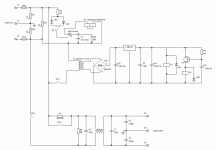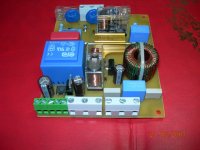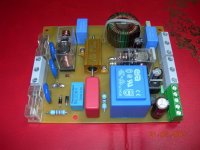forget power factor (PF). Transformers are rated with sinusoid input voltage and resistive loading.
Hi Andrew T,
You Mean A=Va/volt ( A=170/25=6.8 Amp)
AndrewT said:forget power factor (PF). Transformers are rated with sinusoid input voltage and resistive loading.
You Mean A=Va/volt ( A=170/25=6.8 Amp)
AndrewT said:170VA per winding or 170VA for the whole transformer?
Trafo sir
🙂 🙂
Best way is you suggest the best
25-0-25 , 300 VA Trafo
25-0-25 , 225 VA Trafo
Thanks
Hi,
the 300VA transformer can be specified as 300/ [25+25] = 6Aac.
the 225VA transformer can be specified as 225 / [25+25] = 4.5Aac.
the 170VA transformer can be specified as 170 / [25+25] = 3.4Aac.
the 300VA transformer can be specified as 300/ [25+25] = 6Aac.
the 225VA transformer can be specified as 225 / [25+25] = 4.5Aac.
the 170VA transformer can be specified as 170 / [25+25] = 3.4Aac.
AndrewT said:Hi,
the 300VA transformer can be specified as 300/ [25+25] = 6Aac.
the 225VA transformer can be specified as 225 / [25+25] = 4.5Aac.
the 170VA transformer can be specified as 170 / [25+25] = 3.4Aac.
🙂 🙂 Hi
Ampear/rail or half of amp as given above?
what is the question?neeraj said:Ampear/rail or half of amp as given above?
Hi,Andrew T,
The question is say i m using 170 Va trafo for single LM 3886
What is the output of transformer in amp.
0-25=1.7 Amp Or 3.4amp?
25-0-25=3.4 amp or 6.8 amp?
🙂 🙂
With best regards
The question is say i m using 170 Va trafo for single LM 3886
What is the output of transformer in amp.
0-25=1.7 Amp Or 3.4amp?
25-0-25=3.4 amp or 6.8 amp?
🙂 🙂
With best regards
AndrewT said:Hi,
the 300VA transformer can be specified as 300/ [25+25] = 6Aac.
the 225VA transformer can be specified as 225 / [25+25] = 4.5Aac.
the 170VA transformer can be specified as 170 / [25+25] = 3.4Aac.
170VA 25+25Vac = 3.4Aacneeraj said:Hi,Andrew T,
The question is say i m using 170 Va trafo for single LM 3886
What is the output of transformer in amp.
0-25=1.7 Amp Or 3.4amp?
25-0-25=3.4 amp or 6.8 amp?
170VA 25Vac = 6.8Aac.
Use the calculator program built into MSwindows.
neeraj said:Hi,Andrew T,
The question is say i m using 170 Va trafo for single LM 3886
What is the output of transformer in amp.
0-25=1.7 Amp Or 3.4amp?
25-0-25=3.4 amp or 6.8 amp?
🙂 🙂
With best regards
AndrewT said:
170VA 25+25Vac = 3.4Aac
170VA 25Vac = 6.8Aac.
Use the calculator program built into MSwindows.
Dear Andrew T,
I have used the calculator
🙂
But a bit confused 🙁 ,
thanks for your help
with best regards
No, this part powered if you push the power button SB1 and consumes an electricity at the moment of switching. Only varistors directly connect to mains but you may not use they, and you may not use the interference suppressor.a complicated soft start circuit.
And part of it is direct mains powered!
Last edited:
Skip C1, R4, R5, VD1, VD2 and replace K1 with a latching relay for mains voltage. That is easier to build and much safer.
Then the power button with fixing is necessary.Skip C1, R4, R5, VD1, VD2 and replace K1 with a latching relay for mains voltage. That is easier to build and much safer.
If you mean with fixing that you need a switch instead of a button, then no. A latching relay toggles between its two states by means of a ratchet mechanism each time the coil is exited. You often find them in building installations, where lights must be switched on and off from many places, e. g. in an aisle, and where this type is used. Other styles are available from many manufacturers.
There are two types of latching relays. For use with a single pushbutton, the single coil type is the right choice. The type with separate coils for setting and resetting requires two pushbuttons.
There are two types of latching relays. For use with a single pushbutton, the single coil type is the right choice. The type with separate coils for setting and resetting requires two pushbuttons.
Latching relay nice thing but I already used my scheme =)If you mean with fixing that you need a switch instead of a button, then no. A latching relay toggles between its two states by means of a ratchet mechanism each time the coil is exited. You often find them in building installations, where lights must be switched on and off from many places, e. g. in an aisle, and where this type is used. Other styles are available from many manufacturers.
There are two types of latching relays. For use with a single pushbutton, the single coil type is the right choice. The type with separate coils for setting and resetting requires two pushbuttons.
Attachments
Last edited:
question...
My chipamp.com boards are all done. The PSU measured fine, then I attached the amplifier board. Now it blows fuses. I stuck a 10amp fuse in to see what was happening, the traffo heated up in a few seconds, the inside two diodes on the bridge heated up fantastically hot and the outside two not so much. There was a slight hum coming off the board..... Help... Everything looks to be wired correctly.
My chipamp.com boards are all done. The PSU measured fine, then I attached the amplifier board. Now it blows fuses. I stuck a 10amp fuse in to see what was happening, the traffo heated up in a few seconds, the inside two diodes on the bridge heated up fantastically hot and the outside two not so much. There was a slight hum coming off the board..... Help... Everything looks to be wired correctly.
Disconnect the amp again to see if the power supply is still as it was?
Check for too much solder causing short circuits across traces on the PCB?
Check the diodes are in the right way around (a common problem I have read).
Check for too much solder causing short circuits across traces on the PCB?
Check the diodes are in the right way around (a common problem I have read).
Disconnect the amp again to see if the power supply is still as it was?
Check for too much solder causing short circuits across traces on the PCB?
Check the diodes are in the right way around (a common problem I have read).
Well I disconnected the V and PG's and the PSU didn't smoke out on me. So that rules out the error being on the psu amirite?
I guess I'll peel off the amp board tomorrow and give it a good eyeballing...
My diodes will be fine right? They got super-crazy hot when I ran it with the 10amp fuse but it seems ok now?
- Home
- Amplifiers
- Chip Amps
- Chip amp power supply- a beginners guide


